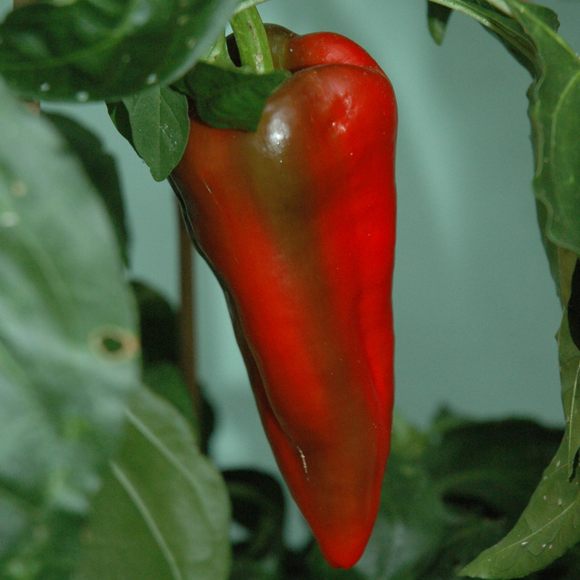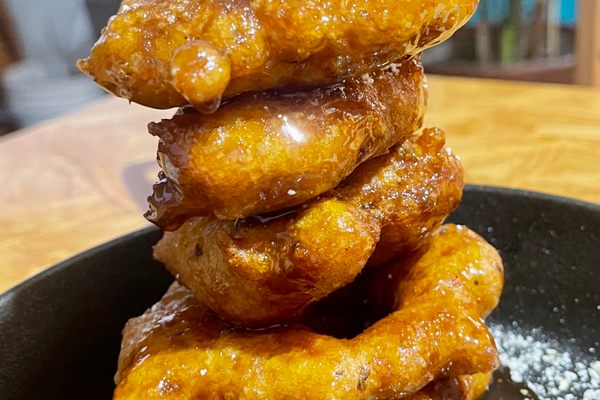Fruits & Vegetables
Beaver Dam Pepper
A pepper so good, Hungarian immigrants carried it with them when they came to Wisconsin.
It is no wonder that the Beaver Dam pepper was nearly lost to posterity, trampled upon by the market demand for easier-to-grow pepper varieties that don’t require such laborious agricultural techniques as planting individual stakes for each pepper plant.
The eponymous pepper came to Beaver Dam, Wisconsin, in 1912, with Joe Hussli, a Hungarian immigrant who couldn’t conceive of a new American life without a little peppery taste of home. Locals and descendants of friends of the Hussli family like to say that the Husslis planted the seeds, grew the peppers, and shared the seeds with friends and neighbors, thus setting up a little community of Beaver Dam pepper growers who appreciated the delicious plant’s mild bite, enough to pass the seeds down for generations. There are pepper-growing families in Beaver Dam who have saved seeds from at least the 1980s. However, over generations, farming of this pepper has dwindled considerably as hybrids flood the market.
Today, Beaver Dam still celebrates its favorite pepper in the form of an annual Beaver Dam Pepper Festival. Fans can buy the prized crop from local growers, eat pepper sausages, and even participate in an apple pepper pie–eating competition with the town sheriff. Current growers, who descend from a long line of Beaver Dam pepper cultivators, also give presentations on the plant’s history.
For locals, preserving the town’s pepper is crucial. The story of its near-extinction is a story of how our current food culture has prioritized efficiency and shelf-life over flavor. The Beaver Dam, an heirloom variety, requires more care in growing than hybrid peppers that are hardier, more disease-resistant, and thus more dependable in terms of yield. But organizations such as Seed Savers and Slow Food USA are building up a steady base of growers yearning for flavor and willing to return to traditional, sustainable methods of farming. Thanks to their interest, the Beaver Dam pepper has been preserved and there are enough seeds available now to bring the pepper back from the brink of extinction.
The peppers start out lime-green but gradually mature to an orange or blood-red color, over a period of 80 days. Between three and eight peppers grow on each plant. Thick-fleshed, the peppers are mild-to-hot with an appealing crunch that is great in salads and fresh salsas. They also go brilliantly sliced into a sandwich or stuffed with a rice or meat filling. And some fans insist that they’re an absolute must in Hungarian goulash. The peppers are between 500 and 1,000 SHU on the Scoville heat scale.
Where to Try It
-
Beaver Dam Pepper Festival Website
Park Village Shopping Center , 820 Park Ave, Beaver Dam, Wisconsin, 53916, United StatesAn annual Beaver Dam Pepper Festival, held on the second Saturday in September, celebrates this local pepper on its home soil.
Written By
 Rohini Chaki
Rohini Chaki
Sources
- www.chicagoreader.com/chicago/beaver-dam-pepper-lee-greene-scrumptious-pantry/Content?oid=20059126
- www.youtube.com/watch?v=3I-wWR-7hPs
- www.wiscnews.com/about-the-beaver-dam-pepper/article_bd2058f8-5071-5c33-8aec-56bc68bf5222.html
- books.google.com/books?id=JfN0DQAAQBAJ&pg=PT33&dq=beaver+dam+pepper&hl=en&sa=X&ved=0ahUKEwiEuLaE4uLiAhViuVkKHasODqgQ6AEINTAC#v=onepage&q=beaver%20dam%20pepper&f=false
- www.slowfoodusa.org/ark-item/beaver-dam-pepper














